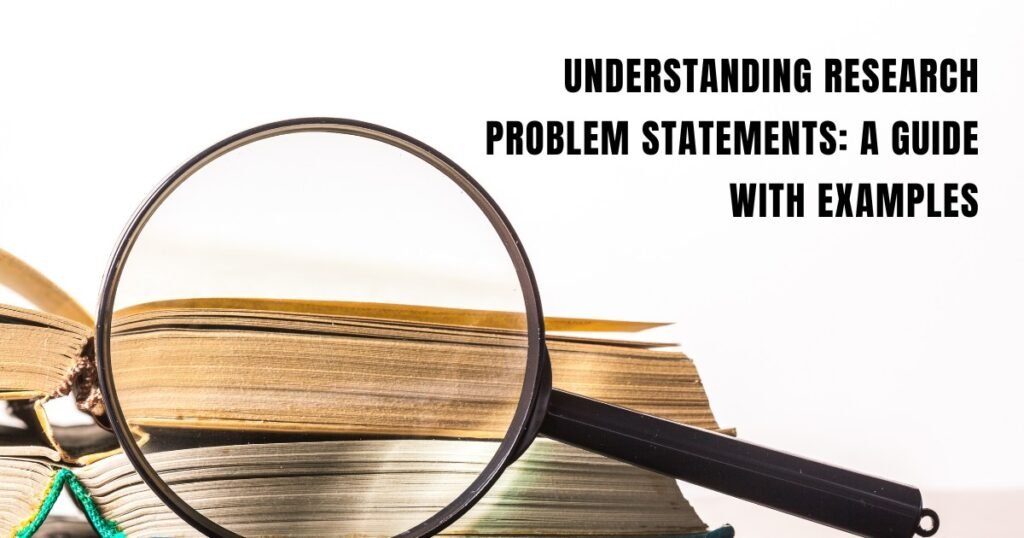
Have you wondered why experts spend so much time clarifying their research problem statements? The research problem statement supports their efforts, directs the investigation, and ensures that it addresses a specific issue. This article helps you develop research problem statements and illustrates their importance. This blog explains Research Problem Statements and provides examples to help you understand them.
What Is a Research Problem Statement?
A research problem statement clearly, straightforwardly, and in detail, outlines the issue or problem the research project aims to solve. It should be written so that experts and non-experts can easily understand it. To write about a research problem, you should:
- First, determine your research interests.
- Get clear about the situation or issue you are interested in.
- Set the scene by explaining why research is important and how it fills a gap in your current knowledge or understanding.
- Use clear, concise language that your audience can easily understand when you describe the problem.
- The problem statement should be written in a neutral and factual tone, avoiding personal bias and subjective language.
What does research problem statements includes?
A research problem statement quickly explains to the reader what problem or issue the researcher wants to solve in their research. Most of the time, it has a few main parts:
- Introduction to the problem: This provides the context for the investigation. This emphasises the significance of the problem to the field.
- Background information: This section summarises problem-related research, ideas, or findings. It is helpful to show the knowledge gap this study seeks to fill.
- Statement of the problem: This dominates the description of the research problem. This clarifies the research goal. The issue statement should be concise and identify essential components or variables.
- Objectives and purpose: This section describes the research objectives. It states what the researcher intends to learn about the research, such as its causes, effects, answers, and new knowledge.
- Scope and limitation: The researcher decides what to include and exclude in this section. This manages expectations for how deep the investigation will go.
- Signify the research: The findings and implications are discussed here. This explains why the research is relevant, who the data might aid, and how they enhance field knowledge or practice.
- Research question or hypotheses: Depending on the research, the issue statement may include questions or hypotheses to test or solve depending on the research.
Conditions and components of a research problem
- The existence of a problem for which no answer is known at this time
- The existence of a person, group, or organization that the problem can be traced back to
- There must be at least two different options for what research can do.
- The action should have at least two possible effects, one of which is better.
The specific components of a research problem include the following:
- The goals of the manager or decision-maker (person, group, or organization)
- The problem’s setting or situation
- What kind of problem
- Different ways to solve the problem
- A list of results that can happen because of actions taken and events that happen outside of the manager’s control
- An unclear situation where the best thing to do is a move
Identifying the research problem
Identifying this research issue is crucial and time consuming. Identifying a research issue requires choosing a specific societal subject. Researchers usually find a research issue by watching, researching, being smart, and having abilities. Finding out what is wrong at work might help you create a research question. Moreover, the following points are considered when deciding on a research problem.
- Large-scale reports and data records in the field may show facts or results based on data that need to be looked into further
- What the researcher is interested in personally
- The researcher’s skills and knowledge
- The ability to get resources like time, money, and enormous amounts of data
- How important different problems are
- The usefulness of being able to solve a problem
- Having the correct data for a problem
Characteristics of research problem statements
Clear and concise research problem statements guide the progress of the research project. A strong research statement helps others grasp the scope and value of the research, which may lead to greater collaboration or exploration. Here are some key points to consider while writing a research problem statement.
- Resolving a problem must be needed:
Pick an issue significant to a group or community, not just your job or field. The research is unnecessary until the problem’s relevance is described in depth. It is crucial to discuss the “need” to undertake research in the context of the topic and how it would help.
- Present the research problem responsibly and clearly:
First, write a concise research statement that non-specialists can comprehend. An excellent research problem statement is both precise and detailed. Ask your pals whether they understand your research challenge; if they cannot, rewrite. Write honestly while addressing all relevant arguments and presenting a convincing case.
- Facts and evidence support the research issue:
Acquire all the research topics and gap information before developing the issue statement. A complete literature review will provide you with an overview of current events and the questions you need to ask to address knowledge gaps. You can’t ask inquiries or locate solved issues. Problem statements should be founded on facts and data, not hypotheticals.
- The research problem should generate more research questions:
The research issue should advance research and inspire further inquiries. New questions may be specific to the research and highlight distinct aspects of the topic. These questions must also provide a complete picture of the situation and support the research project.
- The research problem should be tangible:
A specified research topic should satisfy the research’s duration and budget. The research question shouldn’t need you to do or attempt anything beyond your competence.
Examples of research problem statement
Research problem statement examples help explain what goes into one. The following scenarios demonstrate alternative research problem statement approaches depending on the project subject and type.
- Example 1: This research examines how technology influences current classroom instruction. Specifically, the project will address the following first-hand research questions: What are the positives and downsides of utilizing technology to educate vs. traditional methods? How does classroom technology affect student performance? What techniques work to integrate technology into the classroom?
- Example 2: This research examines teenagers’ media consumption and mental health. Specifically, the project will address the following first-hand research questions: How does media consumption affect kids’ mental health? Does media affect mental health differently for men and women? How can teenagers be encouraged to use media responsibly?
- Example 3: This research examines how social media affects customer behaviour. Specifically, the project will address first-hand research questions: How do social networks affect decision-making? What products and services will social networks alter most? How can firms utilize social media to promote sales?
- Example 4: This research will examine how climate change affects farming in disadvantaged nations. Specifically, the project will address first-hand research questions: How does climate change affect farming in impoverished countries? What measures can reduce climate change’s impact on agriculture? How can policy protect farmers from climate change?
Here are some strategies for formulating an effective research problem statement:
- Figure out the central area of research: You should start by choosing a broad research area based on your experience, knowledge, field, job, and interest. Whatever you know, your interest, or your skill, this area must be important to you.
- Establish the relevance of this research: If you are making a research paper, the problem statement should clarify why the work you are doing now is essential. If you are doing current research, it should explain why previous work is necessary.
- Framing the problem: For workable answers, the problem must be correctly described. Clarifying the problem and its effects on clients or the team can help you develop a good solution. You should also consider the root causes of the problems and any bias surrounding them.
- Write at the beginning of the research process: Once you start researching before collecting or analysing any data, you should write a research problem statement.
Conclusion
Any effective research needs a suitable research problem statement. As a road map, it keeps you focused on your hunt. Following the stages and considering the instances will help you explain the issue your research seeks to answer. Remember that a clear issue description yields simple research questions, a solid approach, and essential outcomes.
FAQs
How to write a statement of the problem in research?
To write a statement of the research problem, begin by providing background information to examine the issue within the existing body of knowledge. Clearly define the specific problem your research aims to address, detailing the gaps or unresolved questions in the literature. Highlight the significance of the problem to justify the need for your study and conclude by outlining the research objectives or questions your investigation seeks to answer.
How to find problem statements in research?
Finding problem statements in research involves conducting a thorough literature review to identify gaps, inconsistencies, or unresolved questions in your field. Engaging with academic peers, attending conferences, and staying updated in recent publications can reveal potential research problems. Additionally, real-world observations and information about current trends and issues in your field can provide practical contexts that necessitate further academic enquiry.
What is statement of problem in research paper?
The statement of the problem in a research paper is a concise section that articulates the specific issue or knowledge gap that the study aims to address. It sets the foundation for the research by providing a clear rationale for the investigation, highlighting its importance, and outlining the objectives or questions that the research seeks to resolve. This statement guides the direction of the study and helps to focus research efforts on addressing a clearly defined problem.
